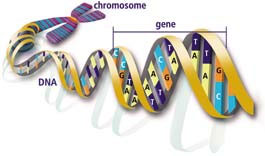AN INTRODUCTION TO GENOMICS: THE HUMAN GENOME AND BEYOND
Sections: What is Genomics?
|
|
What is Genomics?
THE HUMAN BODY consists of trillions of cells. Almost all contain an entire genome—the complete set of inherited genetic information encoded in our DNA. When humans reproduce, the parents' sperm and egg DNA combine to contribute a genome's worth of genetic information to the fertilized embryo. That same information is in each of the cells that eventually make up an organism.
Some segments of DNA, called genes or "coding" DNA, contain the chemical recipe that determines particular traits; genetics is the study of the inheritance and function of these genes. Scientists now estimate that humans have about 30,000 genes, located along threadlike, tightly coiled strands of DNA called chromosomes. Genes, however, are only about three percent of human DNA; the rest is "noncoding" DNA. Within these noncoding regions of the genome is the information that determines when and where genes are active—for example, in which cell types and at what stages in the life of an organism. Genomics is the study of the entire set of DNA sequences—both coding and noncoding DNA.
 Over the past decade, the decoding of the genomes of human beings and other important organisms has sparked an extraordinary biological revolution. The information and technology of genomics is transforming our understanding of human evolution, the mechanisms of disease, the relationship between heredity and environment, and our ancient connection with all forms of life. In the next few years we will see many exciting discoveries leading to a better understanding of the complexity of life, as well as new drugs, vaccines, and diagnostics and less expensive, more efficient, and safer ways to restore the environment.
Over the past decade, the decoding of the genomes of human beings and other important organisms has sparked an extraordinary biological revolution. The information and technology of genomics is transforming our understanding of human evolution, the mechanisms of disease, the relationship between heredity and environment, and our ancient connection with all forms of life. In the next few years we will see many exciting discoveries leading to a better understanding of the complexity of life, as well as new drugs, vaccines, and diagnostics and less expensive, more efficient, and safer ways to restore the environment.
The Human Genome ... By the Numbers
75-100 trillion ... Cells in the human body
3.1 billion ... Base pairs in each cell
2.4 million ... Base pairs in the largest human gene (dystrophin)
28,000-35,000 ... Genes in the human genome
46 ... Chromosomes in each cell
Information taken from the Joint Genome Institute: Joint Genome Institute authored documents are sponsored by the U.S. Department of Energy under Contracts W-7405-Eng-48, DE-AC02-05CH11231, and W-7405-ENG-36. Accordingly, the U.S. Government retains a nonexclusive, royalty-free license to publish or reproduce these documents, or allow others to do so, for U.S. Government purposes. All documents available from this server may be protected under the U.S. and Foreign Copyright Laws and permission to reproduce them may be required. The public may copy and use this information without charge, provided that this Notice and any statement of authorship are reproduced on all copies. JGI is not responsible for the contents of any off-site pages referenced.
All content © 2006-08 by Lori Andrews.
loriandrews.com
